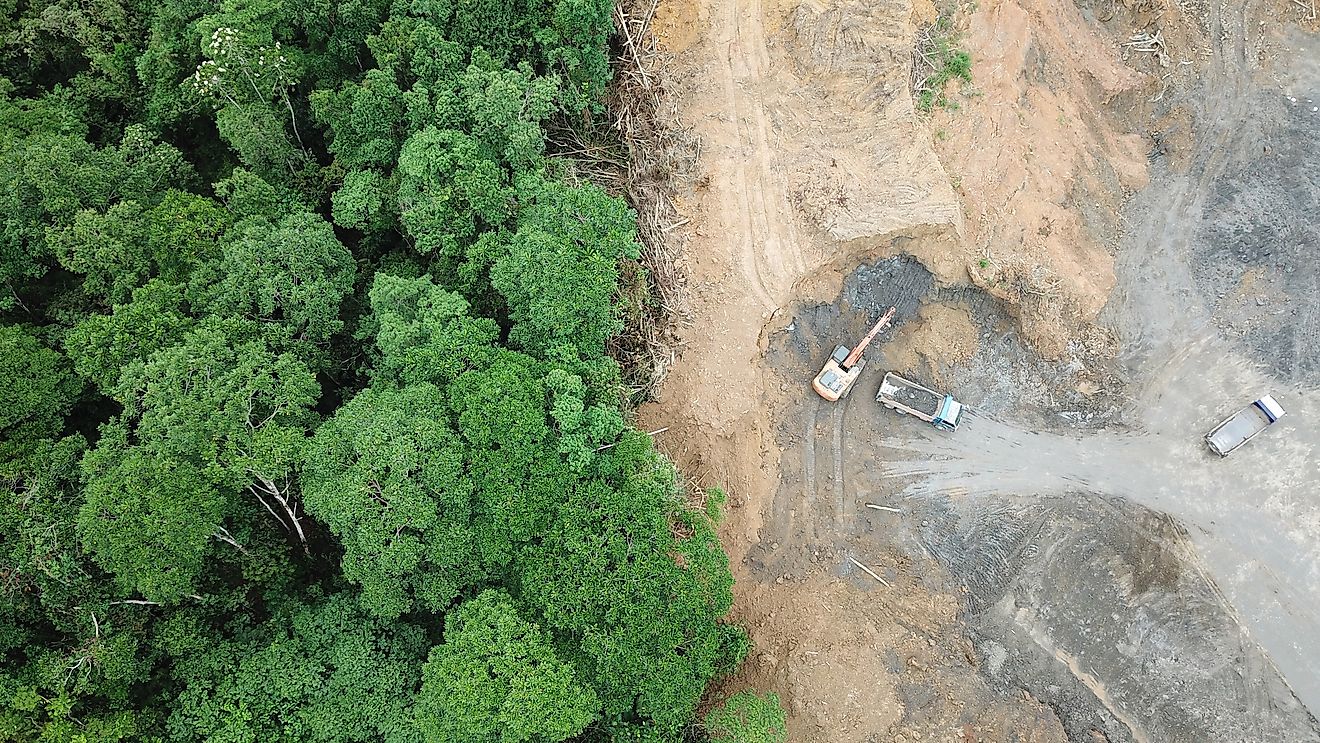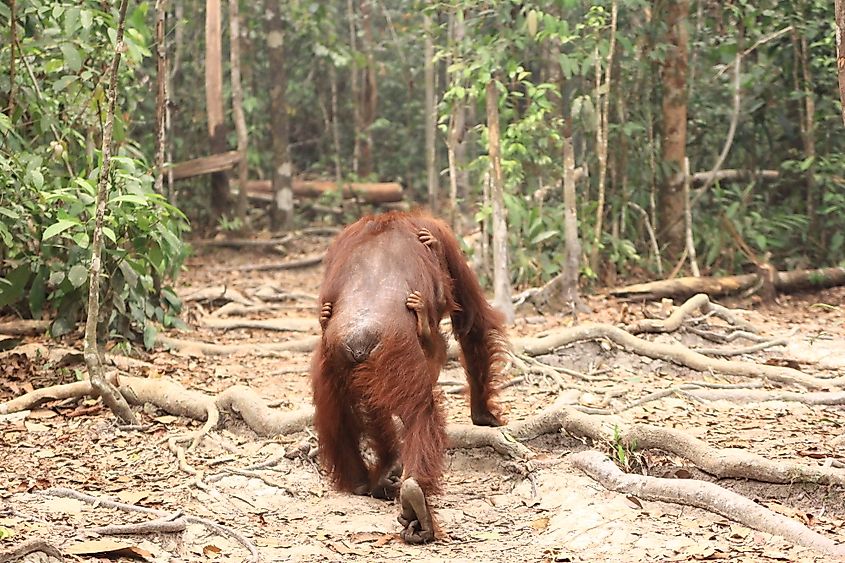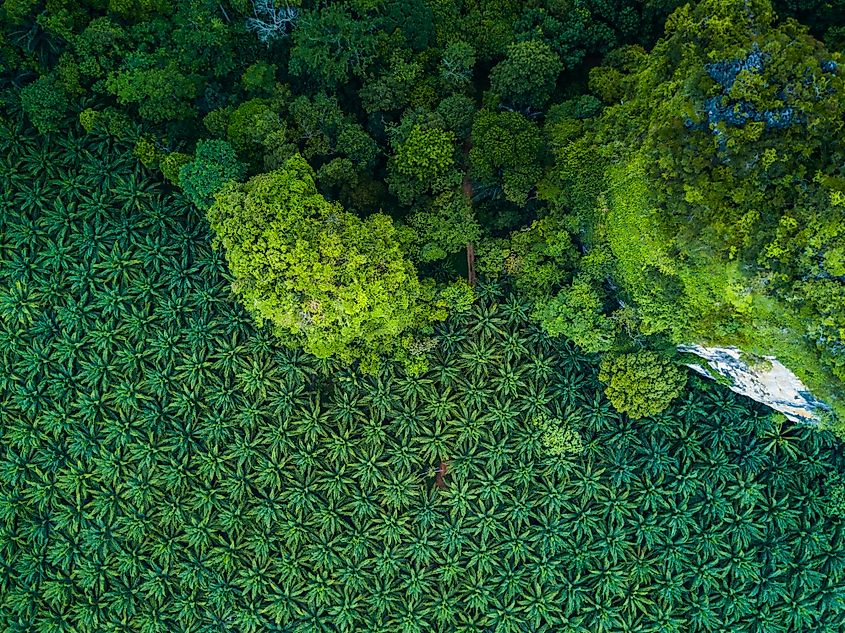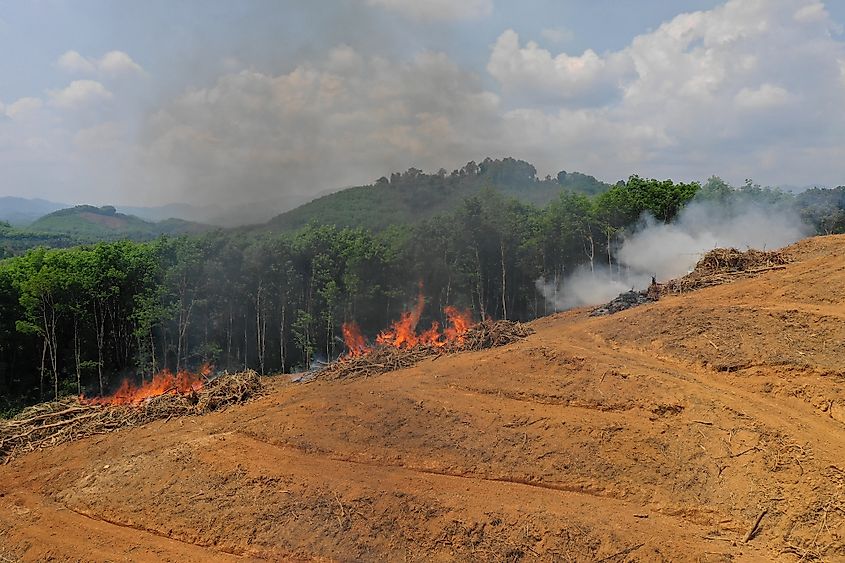10 Reasons How Palm Oil Production Is Endangering Species

- • Oil palms produce around 35% of all vegetable oil in the world.
- • Industrial oil palm plantations currently occupy 18.7 million hectares of land.
- • Global oil palm development leads to deforestation with the sector accounting for 47% of deforestation in Malaysia.
- • Oil palms threaten about 193 endangered, critically endangered, and vulnerable species globally.
Oil palm tree produce fruits from which oil palm is extracted. The scientific name of the tree is Elaeis guineensis. For thousands of years, people have cultivated oil palm in different settings and for various purposes. Since the rise of consumerism and processed food, palm oil has increased to become a global oil commodity. As of 2017, oil palms occupied 18.7 million hectares of industrial-scale plantations. Some view oil palms as land efficient oil crops because they occupy less land than soy and rapeseed and produce more per hectare compared to both soy and rapeseed. Oil palms produce around 35% of all vegetable oil but only sit on less than 10% of land occupied by oil crops. Today oil palm plantations can be found in different countries. Countries with the largest acreage of oil palm in the world include Indonesia, Malaysia, Nigeria, Columbia, Brazil, and Papua New Guinea.
Palm-oil Plantations Trigger Deforestation
Over the years, oil palm plantations have led to high rates of deforestation in palm oil-producing countries. The growth of the palm oil industry in Malaysia has contributed to about 47% of deforestation experienced between 1972 and 2015 in the country. In Indonesia, which is the largest producer of palm oil in the world, about 16% of deforestation was attributed directly to the production of palm oil over the same period. Similar deforestation patterns can be found on the island of Borneo, West Africa, Central, and South America. In Nigeria, one study suggested that oil palms accounted for 3% of forest loss in the early 2000s. Deforestation leads to the destruction of habitats that are crucial for the survival of many species.

Monoculture Destroys Plant Genetic Diversity
Agriculture is ranked as one of the most common threats to species listed on the IUCN Red List. An in-depth search of keywords such as “palm oil,” “oil palm,” and “palm plantation” on the IUCN Red List database reveals that the production of the crop threatens 405 species. One hundred ninety-three of the species mentioned are listed as vulnerable, endangered, or critically endangered. Some of the most severely affected species include orangutans, gibbons, and tigers. Tree and other plant species are also affected as some planted areas have over 99% less plant and tree diversity compared to natural forests. Studies have also shown a reduction in mammalian diversity of 65-90% in oil palm plantations. A majority of species groups decline in both abundance and richness. Given the monoculture nature of oil palm cultivation, it is hardly surprising that plant diversity is lost.

Invasive Traits
There have been reports of the species escaping cultivation and naturalizing. Such incidents of invasive oil palms have been noted on several islands in Micronesia. There are also unconfirmed reports of invasive palm oil trees in Bahia, Brazil, where oil palms are threatening remnants of native coastal Atlantic forest. While the plant is not a major invasive species, it is essential to limit its spread in sensitive ecological sites.
Pest Spillover Is Highly Likely
Oil palm plantations provide favorable conditions and breeding grounds for pests that affect crops. Some of the pests commonly found in oil palm plantations include rats, Rhinoceros beetles, caterpillars, and other leaf-eating insects. Experts have raised concerns that the accumulation of such pests in oil palm plantations could lead to a spillover of damaging pests to adjacent forests. For example, a spillover of large numbers of Rhinoceros beetle could cause significant damage to leaves of native plant and tree species. Oil palm plantations also serve as breeding grounds for microorganisms such as bacteria, fungi, and viruses that cause diseases such as stem rot, a severe fungal infection that affects the oil palm truck. An outbreak of diseases could potentially affect surrounding forests.
Irresponsible Use Of Pesticides Is Bad For The Environment
Conventional agriculture utilizes a “pick and choose” technique of pesticide use, which treats the symptoms of poor land management instead of acknowledging the underlying problems. The method fails to understand agriculture as a system and its impact on wildlife. Pesticides used to control pests and diseases in plantations also cause substantial damage to insect and animal populations living around the plantations. Pesticide poisoning of wildlife may occur as a result of acute or chronic poisoning. Acute poisoning occurs due to short exposure. It can occur when animals consume vegetation that has been treated with harmful pesticides. Chronic poisoning happens for a long period when the levels of pesticides are not immediately fatal. Consumption of animals that have consumed pesticides by prey species can also lead to secondary poisoning. Pesticide use can also lead to indirect effects on the habitat and food supply. For example, insecticides reduce pollinators, which consequently affects plant pollination.
Destruction Of Forested Riparian Reserves
Freshwater fish are dependent on the water quality of streams, rivers, and lakes in which they live. The most widely used strategy to protect the quality of water in production areas is the retention of forests along rivers and streams. Forested riparian areas can reduce chemical runoff, sedimentation, and maintenance of temperature regimes in rivers and streams. In both Malaysian and Indonesia, the retention of riparian reserves is a requirement of the law. Unfortunately, non-compliance is common due to unfortunate enforcement and legal vagueness. In Indonesia, most of the large and small rivers should have a 328 and 164 feet buffer of natural vegetation, respectively. The country, however, lacks definitions of what should be considered a large river, a small river, and natural vegetation.
Fertilizer Use Creates Toxic Runoff
Fertilizers used in oil palm plantations have large quantities of phosphorus and nitrogen. When such chemicals are carried and eventually reach waterways, they can trigger the hastened progression and growth of aquatic plants. The fertilizers can promote fast growth of nuisance algae in a process known as eutrophication. Eutrophication can adversely affect water quality through increased growth of aquatic weeds and algae, which is harmful to marine life. Decomposition of dead algae at the bottom of the rivers and streams could also lead to the removal of oxygen from the water creating zones that are unsuitable for aquatic life.
Use Of Fire For Clearing

The use of fire while clearing land can lead to the extermination of plant and animal species that previously occupied the land. Continuous use of such a technique can have devastating effects on wildlife in the area.
Human-wildlife Conflict
Orangutans are classified as critically endangered animals according to the IUCN Red List. Bornean orangutans have declined by about 25% over the past decade. Researchers have determined that between 1,500 and 2,500 Bornean orangutans are killed annually. Half of that number die as a result of human-wildlife conflict. Such conflicts often occur around areas where agricultural activity is expanding.
Hunting Of Wildlife Is Made Easy
Bearded pigs are an essential source of protein for a significant number of forest-dwelling people. The species has economic and cultural importance for communities living in rural areas in Sumatra, the Malay Peninsula, and Borneo, where it has been a popular source of food for thousands of years. Until recently, the bearded pig was widespread across the Malay Peninsula. During a survey conducted in 2015, direct observation showed the existence of bearded pigs in oil palm plantations. They were seen to feed opportunistically on palm fruits on the ground, an easily accessible and dependable resource. The simplified landscape has, however, meant that they are hunted with relative ease compared to natural forests. As a result, their populations have declined significantly.
Mitigating The Effects Of Oil Palm
The main strategies used in mitigation of the effects of oil palm cultivation on biodiversity revolve around addressing the loss of forests and peatlands. Some of the strategies used to protect these areas include the adoption of certification standards, regulatory policies, and corporate commitments. Conservationists utilize methods in auditing, traceability, and monitoring to realize desired conservation outcomes.











